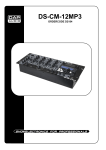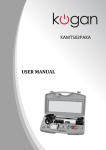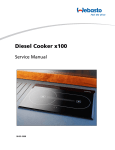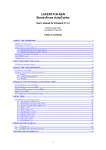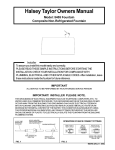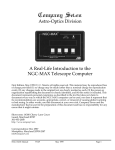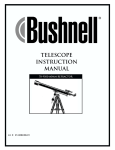Download National Geographic NG90EQ User's Manual
Transcript
NG90EQ Maksutov-Cassegrain Telescope Instructions and Owner’s Manual Parts of your NG90EQ Telescope: A D C B E A. Equatorial mount F B. Counterweight shaft G C. Counterweight D. Slow-motion control knobs (2) L M H I J E. 9-mm eyepiece F. 25-mm eyepiece G. 3X Barlow lens H. Main optical unit K N I. Accessory tray J. Finder scope K. 45º prism L. Mounting plate M. Accessory tray screws (3) N. Tripod bolts (3) O. Tripod legs (3) O A. Equatorial mount screws a. Counterweight bolts B. Counterweight shaft C. Slow-motion control knobs D. 9mm eyepiece E. 25mm eyepiece G. 3X Barlow lens H. Main optical unit I. J. K. L. Accessory tray Finder scope 45º Diagonal prism Mounting plate M. Accessory tray N. Tripod leg O. Tripod Legs WARNING! NEVER aim your telescope at the sun or even close to the sun! Instant and irreversible damage can occur, including blindness! Do not let children use any telescope without adult supervision. 2 Introduction Congratulations on your purchase of a precision-crafted NATIONAL GEOGRAPHIC™ telescope. With proper care and handling of your telescope, you will enjoy the pleasure of looking at nature’s wondrous sights through the eye of this instrument for many years. The NG90EQ has been designed to provide views of the moon’s craters, Jupiter’s major moons, and Saturn’s rings, in addition to dozens of galaxies, star clusters, and nebulae. As a terrestrial (land) telescope, the NG90EQ delivers great views of mountains, valleys, and many other features of the world around us. You can also use the NG90EQ to study animals and landscapes at a distance. To obtain the best performance from your telescope, please read this manual carefully and completely. ! WARNING! CHOKING HAZARD Small parts. Not suitable for children under 3 years. 3 ASSEMBLY 1) Carefully remove all parts from the cardboard cartons and lay them on a table or on the floor in order to take an inventory of all the pieces. Keep your box for storage or in case you ever need to ship your telescope. 2) Each aluminum tripod leg can extend to almost double its closed length. This enables the height of the telescope to be adjusted to comfortably suit most users. Each leg is equipped with a locking knob that can be loosened to perform this adjustment and then retightened. These locking knobs may already be attached to the tripod legs, or they may be packaged in a small plastic bag. If they are already attached you can extend the tripod legs to the desired height and then tighten these knobs. If they are separately packaged you will have to first insert them into the threaded holes located on the side of the black collar near the bottom of each closed tripod leg. 3) The tripod legs now need to be attached to the equatorial mount. The top of each leg is attached with a tripod bolt passed through the holes at the top of each leg. Position one of the three arms of the equatorial mount so that it fits between the leg sections. Insert a bolt through the first tripod section, then through the equatorial mount arm, and finally through the second leg section (See Fig. 1). You will note that one of the leg sections has a hexagonal (8-sided) hole. This is the side from which you insert the bolt. When the bolt comes out the other side, place a round washer and a then a wing nut over the bolt. Tighten the wing nut firmly. NOTE: Each tripod leg has a black metal flap about halfway down its length. This is a bracket to hold the accessory tray and must it be located on the inward-facing side of the tripod leg. (Fig. 1) 4) Attach the accessory tray to the tripod by inserting an accessory tray screw downward through each of the three small holes located near the edge of the accessory tray. Lift up the black metal accessory tray bracket on one tripod leg so that it is at a right angle to the leg. Push the accessory tray screw through the accessory tray and then through the slot in the accessory tray bracket. Place a washer then a wing nut over the screw and tighten the wing nut finger tight (See Fig. 2). Repeat this procedure for the other two accessory tray brackets (See Fig. 3). 4 (Fig. 2) (Fig. 3) 5) The main optical unit is attached to the equatorial mount with a black cast metal mounting plate. This mounting plate has four chromed screws mounted in it. Remove all four screws. The mounting plate has one smooth face and one face with small ridges. Place the smooth face against the underside of the main optical unit. Then insert the two slotted chromed screws through the inner holes so that they engage with the two threaded holes on the underside of the main optical unit. Tighten these with a screwdriver (See Fig. 4). (Fig. 4) 6) Position the main optical unit, with the mounting plate attached, over the equatorial mount as shown in Fig. 5. Insert the two chromed screws with the Phillips (+) heads into the two holes in the equatorial mount so that they engage the two holes at the ends of the mounting plate. Tighten with a screwdriver (See Fig. 6 and Fig. 7). (Fig. 5) (Fig. 6) 5 (Fig. 7) 7) The counterweight balances your telescope and makes it easy to adjust and position. Hold the counterweight in your hand so you can see through the hole in the weight. Make sure that the black tightening knob on the counterweight is facing down. When you look through the counterweight, if you see that the hole is blocked by a metal rod, slowly turn the tightening knob counterclockwise to loosen it until you see that the hole is clear (see Fig. 8). Then insert the counterweight shaft through the counterweight. Turn the tightening knob clockwise to tighten it. Then insert the threaded end of the counterweight rod into the equatorial mount and turn it clockwise until it stops (See Fig. 9 and Fig. 10). (Fig. 8) (Fig. 9) (Fig. 10) 8) Attach the long slow-motion control knob to the chrome right ascension shaft as shown in Fig. 11. Tighten the small chrome knob on the slow-motion control until it is tight against the flat side of the right ascension shaft. Attach the shorter slow-motion control to the chrome declination shaft as shown in Fig. 12 and tighten it into position. Fig. 13 shows the completed assembly. (Fig. 11) (Fig. 12) (Fig. 13) 9) Slide the finder scope into its bracket on top of the main optical unit. Tighten the two small chrome screws to hold it securely in position (See Fig. 14). (Fig. 14) 6 10) Remove the plastic dust cap from the upper eyepiece port and insert the 25-mm eyepiece into the eyepiece holder. Tighten the small set screw to hold the eyepiece securely in place. (See Fig. 15). (Fig. 15) 11) Remove the plastic dust cap from the rear eyepiece port and attach the 45º diagonal prism by turning its collar clockwise over the threaded piece on the back of the main optical unit (See Fig. 16 and Fig. 17). (Fig. 16) (Fig. 17) FINDER SCOPE ALIGNMENT Since a telescope has a narrow field of view by design, it can be challenging to locate a particular star or planet. For this reason the telescope is fitted with a low-power, widefield miniature telescope called a finder scope. Always use your finder scope to locate the object you want to view FIRST. The finder scope should be aligned with the main telescope tube before you begin using the telescope, in order that both scopes are positioned to always provide exactly the same angle and view. Note: Objects in the finder scope are upside down. This is normal and is common to all astronomical telescopes. 7 Complete the following settings in daylight: 1) Insert the 25-mm eyepiece into the eyepiece holder. Look at an easily recognizable, stationary object that is at least 500 feet away. Slightly loosen all locking knobs and move the telescope until the object is in the center of the field of view. Then bring the image into focus. 2) Firmly retighten the locking knobs so that the telescope is locked in position. 3) Look through the finder scope. If the object is not visible or centered in the finder scope, simply release one of the three small adjusting screws holding the finder scope and reposition the finder scope until the object is centered within the X-shaped crosshairs. If the image seen through the finder scope is not clear, turn the eyepiece of the finder scope until the image comes into sharp focus. 4) All screws should be completely tightened as soon as the view through the finder scope coincides with the view of the main telescope. 5) This procedure may need to be repeated to ensure a perfect alignment. THE EQUATORIAL MOUNT Your telescope is equipped with an advanced equatorial mount. This type of mount moves the main optical tube in a circular fashion. This is very important because it means that you can set up the NG90EQ to conveniently compensate for the rotation of the Earth. When you observe an astronomical subject through a telescope it will appear to move across the viewing area. At medium-power magnifications the image can appear to move across the whole viewing area in about 30 seconds. With a simple mounting system, called an altazimuth mount, it can be difficult and frustrating to track an object and keep it in view. The equatorial mount simplifies this operation, but it must be correctly set up. Pick up and rotate the whole telescope until the front of the main optical unit is facing north. Look fairly high in the sky until you see the familiar star grouping called the Big Dipper. By following an imaginary line up from the two end stars of the dipper (the “pointers”), you will come to a single star with no other stars close by. This is Polaris, or the North Star. Loosen the altitude adjustment knob (See Fig. 21) and raise or lower the angle of the telescope until you can see Polaris centered in the finder scope. Be certain that your finder scope is properly aligned. Declination knob (Fig. 21.) 8 You can also adjust the declination by raising or lowering the angle of the main optical unit until the arrow on the degree scale located on the side of the equatorial mount points toward the north latitude of your observing location. If you do not know your viewing position’s north latitude, you can call a local weather office or airport to find out. Use your finder scope to locate an object. Focus on the object and begin observing. As you notice the viewed object move across the viewing area slowly turn the slow-motion cable extending from the left side of the telescope until the object is centered again. If your setup was not accurate you will notice that the subject is moving very slowly either up or down. A slight turn of the declination slow-motion control knob extending from the back of the telescope will counteract this slight error (See Fig. 22). (Fig. 22) A WORD ABOUT THE TWO EYEPIECE PORTS The NG90EQ is fitted with two eyepiece ports. The top port generally is used for astronomical viewing. The view you see will be right side up, but will be laterally reversed, like looking in a mirror. This is normal, and is of no consequence. The rear port, with the 45º diagonal prism attached, is normally used for terrestrial, or land viewing. When an eyepiece is placed in the 45º diagonal prism the view is correctly oriented, like looking through a pair of binoculars, though with much higher magnifying ability. The image produced by the telescope can be directed to one port or the other with the flip mirror on the main optical unit. In Fig. 18 the image is being directed to the upper eyepiece port. In Fig. 19 it is being directed to the rear optical port. (Fig. 18) (Fig. 19) 9 The two eyepiece ports can be used in another way. With an optional camera adapter and appropriate T-ring a 35-mm SLR camera body can be attached to the rear eyepiece port. The 45º diagonal prism must first be removed. With an eyepiece in the top eyepiece port and a camera body attached to the rear eyepiece port a subject can be observed with the eyepiece. Then by simply adjusting the flip mirror, a picture can be taken through the rear eyepiece port. FOCUSING FOR ALL VIEWING IS ACCOMPLISHED BY SLOWLY TURNING THE RUBBERIZED WHEEL LOCATED AT THE RIGHT REAR OF THE MAIN OPTICAL UNIT. IF THE IMAGE SEEN IN THE EYEPIECE IS IN FOCUS, THE IMAGE SEEN BY THE CAMERA WILL ALSO BE IN FOCUS. ABOUT MAGNIFICATION The magnification power of a telescope indicates how much an image is enlarged or how big and close it appears to the viewer. The focal length of the eyepiece, combined with the focal length of the telescope, determines the magnification power. To calculate the power of your telescope with any particular eyepiece, simply divide the focal length of the telescope (1,200 mm) by the focal length of the eyepiece (indicated in “mm” on the eyepiece collar). Example: 1200-mm focal length (tube) 25-mm focal length (eyepiece) = 48X magnification power The following magnification values are achieved when using the Barlow lens and the interchangeable eyepieces: Eyepiece Power Power With 3X Barlow Lens 25 mm 48X 144X 9 mm 133X 400X Higher magnification powers can be achieved by using the included 3X Barlow lens. The 3X Barlow lens is inserted between the telescope and the eyepiece. In Fig. 20 it is shown being used at the rear eyepiece port. It can be used at either eyepiece port. (Fig. 20) 10 The level of magnification required depends on the object being observed. Optimal performance is obtained if the magnification is typically not more than appromiately 30X for every 10 mm of objective lens diameter. Magnification of around 265X or less is ideal for a telescope with a 90-mm diameter objective lens and is best for observing most celestial objects. A lower magnification power and a wider field of view are advisable for the observation of galaxies and nebulae. The highest magnification power should be used for highly detailed observations of the moon, Jupiter and Saturn or any object that is quite bright. The highest magnification power of the Barlow lens/9-mm eyepiece combination should only be used for large or bright objects such as the moon and the brightest planets. We recommend that you begin all observation sessions with the 25-mm eyepiece alone. Then if more viewing power is desired you can either change the eyepiece, add the 3X Barlow lens, or do both. Be aware that as well as brightness being decreased there will come a point when image detail is also lessened. This is further impacted by air pollution, light pollution, and upper-air turbulence. Lower magnification powers lessen these effects. A common mistake made by many beginners is to start an observation session by placing the high-power 9-mm eyepiece and the 3X Barlow lens in the telescope at the same time. This is an exremely high power, dim configuration that “sees” only a very small portion of sky and is therefore very difficult to aim. USING YOUR TELESCOPE FOR ASTRONOMICAL VIEWING 1) Take your telescope outside. We do not recommend viewing objects through closed or open windows. Your view can be distorted by reflections in the glass of a closed window or by air currents of differing temperatures passing through an open window. 2) Let your telescope adjust to the outside temperature. Your telescope will perform much better if the temperature of the lenses and the air inside the tube are the same as the outside temperature. It may take up to 60 minutes to equalize the temperatures when the difference in temperatures is extreme. 3) Find a location far from glaring light. If you live in a large town or city, your viewing will probably improve the farther you move away from the city lights. The sky glow of a town or city can dramatically reduce the telescope’s performance and viewing capabilities. 4) Remove the round plastic dust cover (lens cap) from the front of your telescope. 5) Begin your viewing session by using the 25-mm eyepiece by itself. It will give you the widest angle and the brightest, sharpest views. 11 When possible, avoid sudden temperature changes, as the moisture in the air will condense on the objective lens. Should this occur after bringing your telescope inside, leave the lens cap off the objective lens, tilt the objective (front) lens facedown, and wait until the telescope reaches room temperature. USING YOUR TELESCOPE FOR TERRESTRIAL VIEWING When viewing objects on land, the circular motions of the equatorial mount prove to be a distraction. We are much more familiar with tracking objects by moving from side to side and up and down. The following directions will explain how to set up the equatorial mount to operate in such a manner. Loosen the right ascension tightening knob (See Fig. 23) and carefully rotate the main optical unit until the counterweight shaft is horizontal with the ground. While this knob is loosened you can adjust the position of the counterweight to balance it with the telescope so that the counterweight shaft stays level. You can now control the vertical motion of the telescope by loosening the right ascension tightening knob (See Fig. 23), and you can adjust the horizontal movement by loosening the azimuth locking knob (See Fig. 24). Right ascension tightening knob (Fig. 23) Azimuth locking knob (Fig. 24) 12 CARE AND CLEANING OF OPTICS Optical components of a telescope get dirty over time. Dirt or dust on a lens should be removed with the utmost care. A considerable amount of dirt or dust would have to accumulate on the optical surface before your view would be compromised. 1) Keeping dust caps on during storage and transport will reduce dust collection. 2) Condensation may collect on the optical surfaces when the telescope is not in use. Remove the dust caps and allow the moisture to evaporate naturally. Point the telescope downward to minimize the accumulation of airborne dust. 3) Once all moisture has evaporated, replace the dust caps. 4) Filtered, compressed air may be used to remove surface dust from lenses and mirrors. Remove the dust cap and the dew shield. Once removed, point the can away from the lens and gently expel some air and any condensation or dust that has accumulated on the discharge tube. Spray the lens or mirror with short bursts of air to carefully remove the dust particles. DO NOT HOLD THE TRIGGER OF THE COMPRESSED AIR CAN FOR EXTENDED PERIODS BECAUSE PROPELLANT FROM THE CAN MIGHT ESCAPE AND DAMAGE THE OPTICAL SURFACE. If, after several attempts, you cannot remove the particles, take the telescope to an optical professional for cleaning. If you keep the dust caps on your telescope when it is not in use and avoid handling the lenses or mirrors, only minimal optical maintenance of your telescope should be required. Extensive cleaning is usually only necessary every few years. WHAT TO LOOK FOR IN THE NIGHT SKY There is a whole universe of objects you could view at night, so where do you start? We recommend starting with the most prominent objects first. The moon The moon is the easiest target to find at night. When the moon is in full position, it bathes the night with a silvery light that washes the sky of all but the brightest objects. The best time to view the moon is not when it is full, but rather when it is less than half full. The dividing line between dark and light on the moon, called the terminator, shows the best detail in the craters and mountains. The planets The planets, our solar system companions, range in size and substance from moon-size rocky bodies to giant gas balls, which could hold Earth 1,000 times over. To find the planets, you will need information about their times of visibility. An astronomy magazine will give you the locations of the planets as they change position from month to month. The Internet is also an excellent source of information, offering star charts, maps, and more! 13 The popular and more familiar constellations often provide the easiest landmarks to help find the planet’s locations and paths of orbit. Most people have looked up at the sky at night and seen some of the planets without even realizing it. A planet looks like a bright star but does not twinkle like a star does; it looks like a tiny ball. Venus, Mars, Jupiter, and Saturn are the easiest planets to view. Mercury is dimmer, usually below the horizon, and more challenging to find. Each of the planets provides interesting views. Venus is covered with clouds so all that is visible is an extremely bright light, the brightest next to the moon. However, Venus, like the moon, goes through phases. As it travels around the sun, different areas of its surface are illuminated, producing crescent shapes of varying sizes. Mars is the red planet. When it is above the horizon, it is noticeably red and stands out like a beacon in the night sky. The apparent brightness of Mars varies as the planet orbits around the sun and throughout its period of visiblity, it will look brighter or dimmer depending on its distance from Earth. Jupiter is the largest planet in our solar system and the second brightest next to Venus. Jupiter has many moons, four of which are often visible through your telescope when viewing conditions permit. As you watch them throughout the evening, you will see that they change position relative to each other and to Jupiter. It is possible with careful planning to actually see one of the moons disappear either in front of or behind Jupiter as it orbits around the planet. Another great feature of Jupiter is its cloud belt. Jupiter is alive with weather activity and its clouds have formed over time into belts visible through telescopes in the right atmospheric conditions. Saturn, the second largest planet, is not as bright as Jupiter and so its moons are not as visible through small telescopes. The large rings that encircle Saturn are spectacular to observe, however. The planet and its rings appear pale yellow. The major division in the rings, the Cassini division, is possible to see if you keep the telescope firmly in position. Uranus and Neptune are the last of the solar system’s gas giants. They do not provide as spectacular a sight as Jupiter or Saturn, but are nonetheless rewarding to see. Beyond our solar system there are many more objects to be found. Galaxies, nebulae, and star clusters abound! FREQUENTLY ASKED QUESTIONS 1) How far can I see? If you stand outside and look up at the night sky on a clear evening, you can see hundreds of stars without the aid of your telescope. The telescope is a light-gathering instrument that magnifies the view — providing significantly more detail and unveiling more stars, nebulae, and celestial objects. With the aid of a telescope, you will be able to enjoy exciting views of Saturn’s rings, Jupiter’s major moons, the Orion Nebula, and much more. 14 2) Why can’t I see anything through my telescope? If you see only gray or black when looking through your telescope, even after searching for an object to view, it is very likely that you are using an eyepiece that is too powerful. To solve this problem always start with the lowest power eyepiece first, and only insert the higher-power eyepiece after you have located an object. 3) When I use my high-power eyepiece, everything looks much darker. Why? As magnification in a telescope increases, brightness diminishes. Conversely, brightness increases when magnification is reduced. If an image appears too dark or unclear, use a lower-powered eyepiece. Views of small, bright objects are superior to those of large, dark, or blurry ones! Atmospheric conditions, air currents, as well as light and air pollution also affect viewing quality. 4) As I look through my telescope, objects in the sky appear to move. Why is that? When you observe an astronomical subject through a telescope, the constant rotation of the Earth makes things appear to move across the viewing area. The equatorial mount provided with your telescope compensates for this by moving the main optical tube in a circular fashion, allowing you to follow and study celestial objects with a minimum of manual adjusting. If you would like to reduce this effect of movement to a minimum and observe the widest field of view, you should use lower-power eyepieces. ! WARNING! CHOKING HAZARD – Small parts. Not suitable for children under 3 years. Made in China Manual Part # 260722 National Geographic’s net proceeds support vital exploration, conservation, research, and education programs. Experience the National Geographic Channel. Call your cable or satellite provider for availability. Visit our website: www.nationalgeographic.com 2003 National Geographic Society. NATIONAL GEOGRAPHIC and Yellow Border are trademarks of National Geographic Society. All rights reserved. 15















